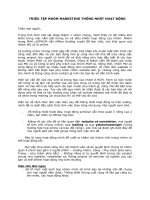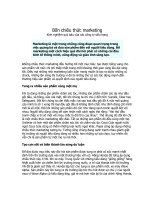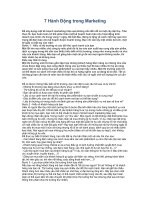Principle Marketing Segmentation – Targeting - Positioning
Bạn đang xem bản rút gọn của tài liệu. Xem và tải ngay bản đầy đủ của tài liệu tại đây (1.09 MB, 37 trang )
S-T-P
Segmentation – Targeting - Positioning
“I don’t know the key to success but the key to failure is trying
to please everyone”
Why marketers need to S-T-P?
•
•
Companies cannot appeal to all buyers in the marketplace or in the same way
•
Companies vary widely in their abilities to serve different segments of the
market
Buyers are too numerous, widely scattered and varied in needs and buying
practices
S- Market Segmentation
T- Market targeting
P- Market Positioning
Company aims at designing customer-driven marketing strategies
that build the right relationships with the right customers
Welcome
to S-T-P
How to segment the marketplace?
•
How to select target market segment(s)?
•
How to differentiate and Position?
•
3
2
1
Today’s Overview
Learning Objectives
•
•
•
•
Understand cornerstone
concepts
Know criteria to segment market
Know criteria to select target
market(s)
Know how to differentiate and
position products/services
Market Segmentation
Market
•
•
Buyers who differ in one or more way
Way: wants, resources, locations, buying attitudes and buying practices
Market Segmentation
•
Divide large, heterogeneous markets into smaller segments that can be
reached more efficiently and effectively with products and services that match
their unique needs
•
Segmenting: consumer markets, business markets, international markets
Segmenting consumer markets
Geographic segmentation
Demographic segmentation
Psychographic segmentation
Multiple segmentation bases
Geographic segmentation
•
Dividing the market into different geographical units such as nations, regions,
cities or neighbourhoods
Demographic segmentation
•
Dividing the market into groups based on demographic variables:
– Age and life-cycle stage
– Gender
– Income
Psychographic segmentation
•
Deviding a market into different groups based on social class, lifestyle or
personality characteristics
– AIO
– VALS
Behavioral segmentation
•
Dividing a market into groups based on consumer knowledge, attitude, use or
response to a product
– Occasions (occasions when they get the idea to buy, make their purchase or use the
purchased item
– User status (potential user, first-time user, regular user)
– Usage rate (light, medium, heavy)
– Loyalty status (macolyte – Mac Zealot)
Using multiple segmentation bases
•
Geodemographics – the study of the relationship between geographical
location and demographic (CACI Market Analysis Group – ACORN)
Requirements for segmentation
•
•
•
•
•
Measureable: size, purchasing power and profits of a market segment can be
measured
Accessible: the market segments can be effectively reached and served
Substantial: market segments are large or profitable enough to serve
Differentiable: segments are conceptually distinguishable
Actionable: effective programs can be designed for attracting and serving the
segments
Market targeting
Company Logo
Evaluate market segments
•
•
•
Segment size and growth
•
The largest, fastest-growing segments are not always the most attractive ones
for every company
Segment structural attractiveness
Company objectives and resources
Selecting target market segments
Local/individual
Local/individual
marketing
marketing
Niche
Niche marketing
marketing
Segmented
Segmented
marketing
marketing
Mass
Mass marketing
marketing
Targeting broadly
Targeting narrowly
Selecting target market segments
•
Target market – a set of buyers sharing common needs or characteristics that
the company decides to serve
•
Undifferentiated marketing (mass): market coverage strategy which a firm go
after the whole market with one offer
Selecting target market segments
•
Differentiated marketing – segmented marketing, a firm decides to target
several market segments and designs separate offers for each
Selecting target market segments
•
Concentrated marketing (niche marketing) a market – coverage strategy in
which a firm goes after a large share of one or a few submarkets
Selecting target market segments
•
Micromarketing – a form of target marketing in which companies tailor their
marketing programs to the needs and wants of narrowly defined geographic
– Local marketing
– Individual marketing









